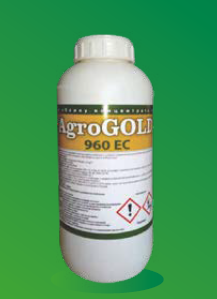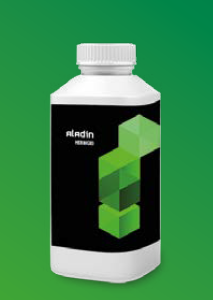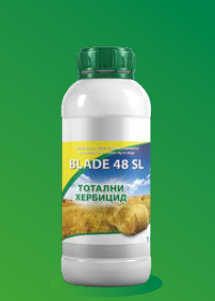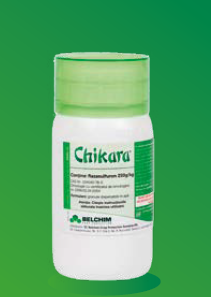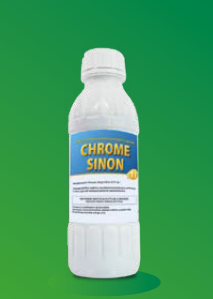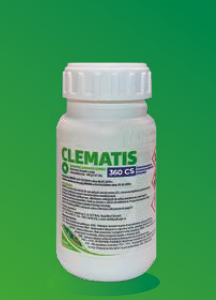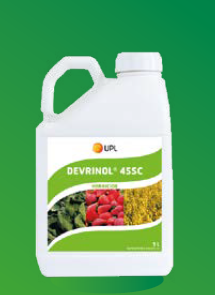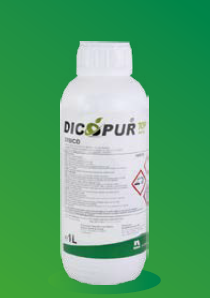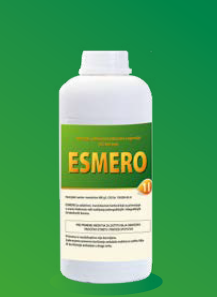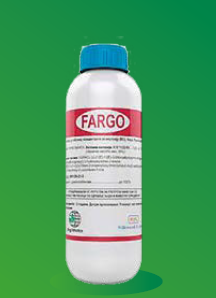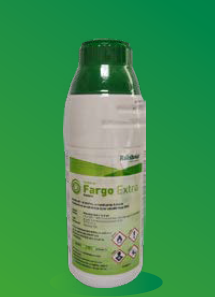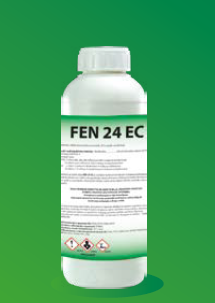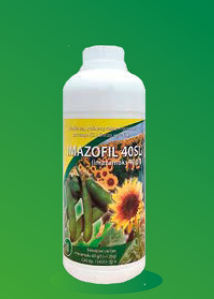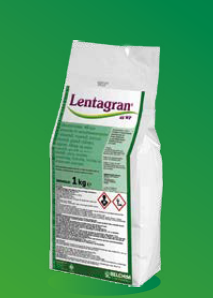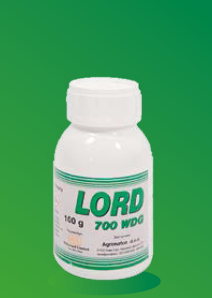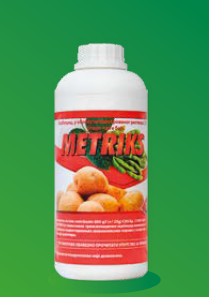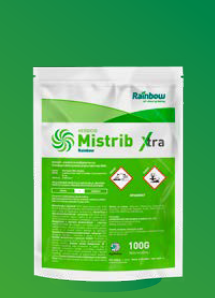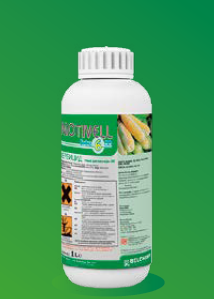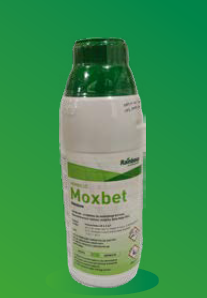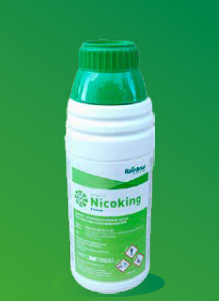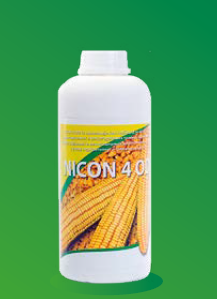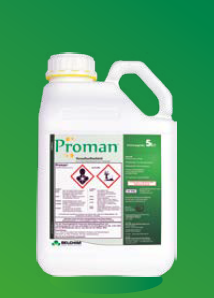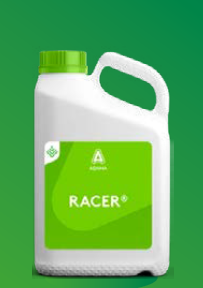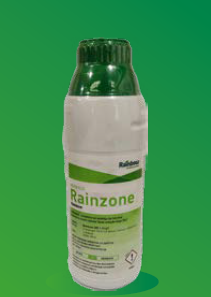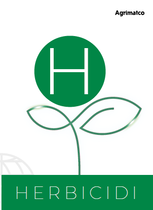
Herbicides are various chemical compounds, mostly of organic origin, intended for the destruction of plants. The word herbicide originates from the Latin words herbum (herbi) which means grass, plant and caedare which means to kill, destroy. All compounds with phytocidal properties could be labeled herbicides.
However, in a practical sense, herbicides mean only those compounds that are used in the fight against weeds, although herbicides can also affect cultivated plants, which requires a good knowledge of the effects of each herbicide.
AGRO GOLD
Selective systemic herbicide for the control of grasses and somebroadleaf weeds in corn, soybean, sunflower and sugar beets.Active substance: S - metolachlor.......... 960 g/lFormulation: concentrated emulsion (EC)Mode of action:Vasal contains S - metolachlor which is adopted by stabaocet and minorpartly by the root of a sprouting weed plant. Works on weeds asgrowth inhibitor, especially as an inhibitor of hypocotyl elongation and due totherefore, it must be applied before the emergence of grass weeds or at the latestuntil the formation of two real sheets. Weeds that absorb the preparation from the soildie before emergence or immediately after emergenceland surface. For good action, like all other land onesherbicides, requires a certain amount of moisture in the soil.Application:- In the crop of mercantile and silage corn, soybeans and sugar beets- in a dose of 1.4 - 1.5 l/ha (depending on the type of soil and humus content)after sowing and before the sprouting of crops and weeds.- In the sunflower crop - at a dose of 1.0 - 1.2 l/ha (depending on the type of soiland humus content) after sowing and before the emergence of crops and weeds.Spectrum of action: Annual and some perennial grass andbroadleaf weeds.Weed species it controls well:- one-year grass (scolysate) weeds, such as: weed millet(Echinochloa crus-galli), wild sorghum from seeds (Sorghum halepense), cornflower (Bromus mollis),red magpie (Digitaria sanguinalis).- annual broad-leaved weeds, such as: Amaranthus retroflexus, Amaranthus blandus(Amaranthus blitoides), common tust (Portulaca oleracea).Mixing with other preparations:It can be mixed in the corn crop with preparations based on terbuthylazine (TERAZOR 50 SC) and mesotrione(Metto), in the soybean crop with preparations based on metribuzin (LORD 700 WDG) and in the sunflower cropwith flurochloridone-based preparations.Maximum number of treatments on the same surface during the year: once.Waiting period: 70 days for silage corn, provided by the application time for mercantile corn,soy and sunflower.Toxicity: III group of poisonsPackaging: 1 liter
Aladin
Selective translocation herbicide for the control of annual iof some perennial broadleaf weeds in soybean and corn cropsActive substance: bentazone 480g/lFormulation: concentrated solution (SL)Application: ALADIN is applied in corn and soybean crops inamount of 3-4 l/ha (30-40 ml per 100 m2) by treating after germination andemergence of weeds, i.e. when broad-leaved weeds are found in the younger onesdevelopment stage 2-6 leaves and corn up to the fifth developedleaf (15 BBCH-scale) or soybeans in the stage from the first to the third trefoil(11-12 BBCH-scale).Spectrum of action:Controls well: linden of theophrastus (Abutilon thophrasti), common styr(Amaranthus retroflexus), stir hybrid (Amaranthus hybridus),field convolvulus (Bilderdykia convolvulus), common ash(Chenopodium album), heart-leaved ash (Chenopodiumhybridum), common datura (Datura stramonium), field watermelon(Hibiscus trionum), bird's-eye flower (Polygonum aviculare), bird's eye flowerlarge (Polygonum lapathifolium), field mustard (Sinapis arvensis),common assistant (Solanum nigrum) and common bottle (Xanthiumstrumarium).Satisfactorily suppresses: diaper ambrosia (Ambrosiaartemisiifolia).Weakly suppresses: Bonito (Cirsium arvense) and Poponac (Njiva).(Convolvulus arvensis).Water consumption: 200-400 l/ha (2-4 l per 100 m2).Note for application: Preferably by treatment in the late afternoon hours. Do not treatat temperatures above 25 °C.Mixing: In the soybean crop, mix it with Imazofil and Moxbet to broaden the spectrumactions. In corn, mix it with preparations based on Dicamba. Do not mix with graminicidesnor with organophosphorus insecticides.Crop rotation: Bentazone decomposes quickly in the soil, so there is no danger for the next crop. In the event that crops fail or are removed prematurely, soybeans and alfalfa can be sown after application and small grains.Waiting period: 63 daysPackaging: 1 liter
Blade 48 SL
Volume:
1 l
BLADE 480 SL is a non-selective (total) systemic herbicide for controlling perennial rhizome weeds, as well as annual and perennial narrow-leaved and broad-leaved weeds on non-agricultural and agricultural areas.It is applied exclusively to sprouted weeds that adopt it with their green parts.Active substance: glyphosate.....................480 g/lFormulation: concentrated solution (SL)Application:1) in orchards and vineyards, by treating when the weeds are 15-40 cm high, in the dose: a) 2-4 l/ha, for controlling annual weeds b) 4-8 l/ha, for controlling perennial weeds c) 8-12 l/ha, for controlling extremely resistant perennial weeds2) on stubbles, in a dose of 3-10 l/ha, for the suppression of annual and perennial narrow-leaved and broad-leaved weeds, by treatment depending on the weeds present, in the phase of intensive growth until the phase of full flowering.3) for suppression of shoots and stumps, by treatment immediately after cutting the tree, in conc. 10% in the period May-December.4) before preparing the soil for sowing or planting agricultural crops in a dose of 2-6 l/ha, depending on the type and stage of weed development5) on meadows and pastures by treating when weeds are in the phase of intensive growth, at a dose of 2-8 l/ha, depending on the type and stage of weed development6) for desiccation of oilseed rape, in a dose of 2-4 l/ha, treated 14 days before harvest7) in dry canals or occasionally flooded canals and swamps, which are brought to culture afterdrainage in a dose of 4-8 l/ha8) in forestry, in a dose of 4-12 l/ha depending on the type of plantings and weeds to be controlled9) on non-agricultural areas, as a total herbicide, in a dose of 3-12 l/ha, by treating when the weeds are in the phase of intensive growth until the full flowering phase.10) on homesteads, the area around industrial buildings, power lines, cemeteries, etc., using backpack sprinklers, in concentration:- 1% (100 ml in 10 l of water), for controlling annual weeds- 2% (200 ml in 10 l of water), for controlling perennial weeds.The dosage of the preparation depends on the type of weed being treated and the degree of weediness.• 4 l/ha for the control of sedges, magpies, sedges, sedges, ragweeds, sedges, sedges, styra, field sedge, micelles, violets, thistles, thistles,• 4-6 l/ha to control wild sorghum from rhizomes, bonito, mint, tansy, dandelion,...• 6-8 l/ha for control of blackberry, blackberry, and wild blackberry• 8-12 l/ha for control of horsetails (horsetails)Waiting period:• fruit and vines – 35 days,• pre-harvest application in small grains and oilseed rape – 14 daysToxicity: III group of poisonsPackaging: 5, 1, and 0.25 litersBefore applying the preparation, be sure to read the instructions for use!
Chikara 25 WG
Contact-systemic herbicide for the control of annual andperennial narrow-leaved and broad-leaved weeds in vineyardsolder than four years, olive and citrus fruit plantations,non-agricultural areas (railways, embankments, industrialarea), nurseries of forest and ornamental plants.Active substance: flazasulfuron .......... 250 g/kgFormulation: water-soluble granules (WG)Application, dosage and mode of actionGrape vines, citrus fruits, olives- It is used in plantations of higher growing forms older than four yearsin the amount of 60-200 g/ha of treated area. The height of the dose affects moreon the length rather than on the spectrum of action.- During spraying, weeds can be no more than 10 cm high.- CHIKARA 25 WG combines well with base productsactive substance glyphosate in a dose of 4-6 l/ha means based on it480 g/l glyphosate.- Due to the excellent and long action over the ground CHIKARA 25WG can also be used at a time when weeds have not yet emerged (e.g.late autumn and early spring). Then it is not justified in combinationalso use glyphosate since it only works through the leaves.- Combination of Chikara 25 WG and glyphosate in most cases as oneby spraying it solves the problem of weeds in plantations. If there is a need forcorrections in late summer or autumn can be used for correctionpreparation based on glyphosate.- CHIKARA 25 WG has a very long effect on soil,hence the multi-year use of CHIKARA 25 WG herbicideaccording to the proposed program, it decreases from year to yearweediness of plantings, and the dose of the herbicide itself can be reduced.NOTE: in plantations, the herbicide is treated mainly in strips (about a third of the area). Sofor the treatment of an area of 1 ha, one third of the dose is needed, so it is recommended in practice30 - 60 g of the preparation CHIKARA 25 WG in combination with 1.5-2 l/ha of the preparation based on glyphosate.RAILWAYS, PUBLIC AREAS (INDUSTRIAL AREAS, BUILDING AREAS,REMAINS OF BUILDINGS FROM HISTORY, CEMETERIES, SQUARES, ROAD STRIPS, CITY AREAS),- In an amount of up to 200 g/ha (20 g per 1000 m2) with the consumption of 200-400 l of water/ha, treating from March to April when the weeds are in the budding phase.- To extend the control spectrum, use in combination with 5-7 l/ha of means based on 360 g/l of activesubstances glyphosate.AdvantagesCHIKARA 25 WG contains Flazasulfuron which has:• the longest effect on weeds in plantations• the widest range of action in the group of residual (ground) herbicides• Synergy with glyphosate• Easy to useFavorable toxicological and ecotoxicological properties:• Safe for bees• Outside the poison group• Favorable in the integral production of herbs.Withdrawal period: 63 days for vines, 30 days for olives and citrus fruits.Packaging: 50g, 200g
CHROME SINON
Selective herbicide intended to control narrow-leaved and broad-leaved weeds in the soybean cropActive substance: clomazone 500g/lFormulation: emulsion concentrate (EC)application:CHROME SINON is a selective translocation herbicide usedfor the suppression of narrow-leaved and broad-leaved weeds in the soybean crop in quantity0.5 l/ha when soybeans are in the stage of 1-3 trefoils (BBCH 11-13), and weedsfrom the pod stage to 5 leaves.Water consumption: 200 - 400 l/ha (2 - 4 l per 100 m2).Maximum number of treatments in one year on the same surface:one time.Spectrum of action:Controls well: red magpie (Digitaria sanguinalis), weed millet(Echinochloa crus-galli), gray fly (Setaria glauca), green fly(Setaria viridis), common ash (Chenopodium album), ashheart leaf (Chenopodium hybridum), mustard (Sinapis arvensis).Controls satisfactorily: Amaranthus retroflexus, tatulaordinary (Datura stramonium), assistant (Solanum nigrum),theophrastus linden (Abutilon theophrasti), common bottle (Xanthiumstrumarium).It is weakly controlled by: bonito (Cirsium arvense), fennel(Bilderdikia convolvulus).Advantages: Excellent synergistic partner, complements and enhances the effectiveness of the partner herbicide.It can be applied before and after soybean sprouting. It tolerates dry periods very well.Withdrawal: provided by the time of applicationWorking grace period: after drying of the deposit.Packaging: 1 lit., 0.2 lit
Clematis
Volume:
250 ml
CLEMATIS is a selective herbicide intended for the control of annual narrow-leaved and annual broad-leaved weeds in winter oilseed rape, potatoes, carrots, spring peas, spring beans, cabbage, melons, peppers, soybeans, tobacco, tomatoes.Active substance: clomazone .......... 360 g/lFormulation: capsule suspension (CS)APPLICATION, DOSAGE AND METHOD OF ACTIONWINTER OIL ROPE: It is applied in a quantity of up to 0.33 l/ha, after sowing before crop emergence.CARROTS, PEAS, SPRING BOB: It is applied in the amount of 0.25 l/ha, after sowing before crop emergence.POTATOES: It is applied in an amount of up to 0.25 l/ha, after planting but before potato sprouts (during spraying, a maximum of 10-20% of potatoes can start sprouting)CABBAGE: It is applied in the amount of 0.27 l/ha, before planting cabbage.PEPPER, TOMATO: In pepper and tomato, grown in the open field, it is applied in the amount of 0.27 l/ha, before planting.TOBACCO: It is applied in the amount of 0.4-0.5 l/ha, by treating the soil before planting tobacco or 2-4 days after planting tobaccoSOY: It is applied in the amount of 0.3 l/ha, after sowing and before crop emergence.MELON: In melon grown in the open field, it is applied in the amount of 0.27 l/ha, by treating the land before planting the melon.SPECTRUM OF ACTION: annual narrow-leaved and broad-leaved weeds:-In the amount of 0.2-0.3 l/ha of good control: red sedum (Anagallis arvensis), common ash (Chenopodium album), small geranium (Geranium dissectum), wild lettuce (Lactuca serriola), bulk (Papaver rhoeas), wild sedge (Raphanus raohanistrum), field mustard (Sinapis arvensis), common sedge (Stellaria media), annual sedge (Stenactis annua), cow grass (Thlaspi arvense).- Satisfactorily suppresses: odorless chamomile (Matricaria inodora), field violet (Viola arvensis)-Poorly suppresses: common sedum (Lepidium draba), common nightshade (Veronica hederifolian, Persian nightshade (Veronica persica), field violet (Viola arvensis).-In the amount of 0.75 l/ha, it suppresses well: common sedge (Capsellabursa-pastoris), common ash (Chenopodium album), heart-leaved ash (Chenopodium hybridum), red magpie (Digitaria sanguinalis), big fly (Echinochloa crus-galli), gray fly (Setaria glauca), green fly (Setaria viridis) wild from of seeds (Sorghum halepense), one-year sorghum (Stachys annua).-Satisfactorily controls: bland gorse (Amaranthus blitoides), common gorse (Amaranthus retroflexus), common datula (Datura stramonium), field watermelon (Hibiscus trionum), common helper (Solanum nigrum), common bottle gourd (Xanthium struma).-Poorly suppresses: linden of Theophrastus (Abutilon theophrasti), sedge (Bilderdykia convolvulus), bonito (Cirsium arvense), sedge (Convolvulus arvensis), wild sunflower (Helianthus annus), large sunflower (Helianthus annus), Pofoligonum dvornik (Pofoligonum dvornik) persicaria), wild sorghum from the rhizome (Sorghum halepense).RECOMMENDATIONPOTATO PRO PROTECTION PROGRAM - PROMANA step forward for safety and breadth in weed protection:- lower doses on lighter types of soil and in situations where potatoes are already nothing-more doses on heavy soils and before emergenceAdvantages- Excellent synergistic partner (complements and increases the efficiency of the partner).- PROMAN and CLEMATIS are an ideal combination in potato protection.- Excellent effect on some key weeds (eg Galium aparine).- The new encapsulated (CS) formulation allows for a slow release of the active substance, thus a prolonged effect and better selectivity.-It tolerates dry periods very well.PACKAGING: 1l, 250 ml
Devrinol 45 FL
Volume:
1 l
Herbicide for control of seed narrow-leaved and broad-leaved weeds in tobacco, oilseed rape, peppers, kale, cabbage, cauliflower, watermelon, strawberries, orchards and vineyards older than one year.Active substance: napropamide ......... 450 g/lFormulation: concentrated suspension (SC)DEVRINOL is a soil herbicide with a very broad spectrum of action for controlling annual narrow-leaved and numerous annual broad-leaved weeds. DEVRINOL is registered in crops where the choice of available herbicides is limited and therefore an excellent choice in weed control programs in those crops. DEVRINOL together with other herbicides provides robust protection against weeds. DEVRINOL has a very long action and in protection programs it is very important for weed control during the entire growing season. For optimal action, it is necessary to incorporate DEVRINOL shallowly into the soil to a depth of 2-5 cm. Smaller doses are applied on lighter soils, and higher on heavier soils. DEVRINOL is effective on very small weeds, i.e. on emerging weeds.APPLICATION AND DOSAGE• CANOLA: DEVRINOL 1-1.5 l/ha + RAPSAN 1-1.25 l/ha + CLEMATIS 0.2-0.25 l/haThe triple combination is the most complete solution in oilseed rape:- Addition of DEVRINOL to the well-known combination for a very wide range of weeds and enhanced actionon Matricaria spp., Apera spica-venti, Geranium dissectum, Veronica spp, Papaver rhoeas, etc.)-Efficiency depends minimally on the type of soil, moisture in the soil and quality of soil preparation-The ratio between the active materials enables a dose for optimal selectivity of oilseed rape- Use exclusively before the sprouting of rapeseed- No incorporation required.• KALE, CABBAGE, CAULIFLOWER:Before planting8-10 days after transplanting2-3 weeks after transplanting10-14 days after the first sprayingCABBAGE Devrinol 2-4 l/ha(shallow incorporation)Rapsan 1.5 l/ha Lentagran 1 kg/ha+ Rapsan 0.25 l/haLentagran 1 kg/ha+ Rapsan 0.25 l/haKALE, FLOWERS Devrinol 2-4 l/ha(shallow incorporation)Rapsan 1.5 l/ha Lentagran 0.75 kg/ha+ Rapsan 0.25 l/haLentagran 0.75 kg/ha+ Rapsan 0.25 l/ha• TOBACCO: SEEDLINGS PRODUCTION: before sowing tobacco, in a dose of 3 l/ha with shallow incorporation on2-5 cm deep, or immediately after sowing tobacco, in a dose of 4 l/ha by surface application and irrigation.IN THE FIELD: before planting in a dose of 3-5 l/ha with shallow incorporation at a depth of 2-5 cm.• WATERMELON: 2-4 l/ha before sowing or planting, with shallow incorporation at a depth of 2-5 cm.• STRAWBERRIES: Early in the spring, during the rest of the vegetation, just before the emergence of weeds orafter the seedlings are received, when establishing a new plantation in a dose of 3-6 l/ha.• PEPPER (except early variety), TOMATO (from seedlings): 2.5-4 l/ha after preparing the soil for planting,only in the field before planting, with shallow incorporation at a depth of 2-5 cm.• ORCHARDS and VINEYARDS older than one year: In the spring, before the emergence of weeds or aftertillage, with shallow incorporation in a dose of 7-10 l/ha. The product must not get on the green partsfor now. The product is effective at the stage of weed emergence.PACKAGING: 100 ml, 1L
Dicopur Top 464 SL
Volume:
1 l
Systemic translocation herbicide for the control of annual i perennial broadleaf weeds.Active substance: dicamba 120 g/l + 2,4-D 344 g/lFormulation: Concentrated solution (SL)General features:DICOPUR TOP 464 SL is a systemic translocation herbicide with a wide spectrum of action for the control of annual and perennial broadleaf weeds in wheat, barley and corn crops.Application:-Corn:for the control of annual and perennial broad-leaved weeds at a dose of 0.8 - 1 l/ha, in stage 3 - 5 of corn leaves (stages 13 - 15 of the BBCH scale)-Wheat, barley: for the suppression of annual and perennial broad-leaved weeds in a dose of 0.8 - 1 l/ha, in the phase from the middle of budding to the appearance of the second leg (phases 24 - 32 of the BBCH scale).Spectrum of action: Broad-leaved weedsAbutilon theophrasti, ambrosia artemisifolia, Amaranthusretroflexus), thistle (Xantium strumarium), datula (Datura stramonium), assistant (Solanumnigrum), bonito (Cirsium arvensis), wild pepper (Polygonum persicaria), mustard (Sinapisarvensis),...Advantages of the preparation:- Synergism - a combination of two effective active substances that complement each other in their action- Wide range of activities- Effectiveness – extremely effective in suppressing even the most resistant broadleaf weedsWaiting period:Maize, wheat, barley - provided by the time of applicationPackaging: 1 LBefore applying the preparation, be sure to read the instructions for use!
ESMERO
Selective systemic foliar and soil herbicide thatapplied to control annual broad-leaved and someof narrow-leaved weeds in the corn crop for grain and silage.Active substance: mesotrione.......... 480 g/lFormulation: concentrated suspension (SC)Mode of action:- It is absorbed through leaves and roots- Mesotrione prevents the synthesis of carotenoids, which is reflected in "bleaching."effect" ie in complete bleaching of the leaves.- Weeds die about 2 weeks after foliar application and codesoil applications, weeds die in the budding phase.Application:It is used in mercantile and silage corn crops- After sowing and before emergence of corn and weeds in a dose of 0.25 - 0.3 l/ha- After the emergence of corn and weeds, when the corn has 2-9 leavesand weeds in the stage of 2-8 leaves in a dose of 0.15-0.25 l/ha.Water consumption: 200-300 liters of water per hectare.Spectrum of action: broad-leaved weeds and side effect onnarrow-leaved (grass) weeds- Weed species that it controls well: abutilon (Abutilon theophrasti),ragweed (ambrosia artemisiifolia), tatula (Datura stramonium),thistle (Xanthium strumarium), mustard (Sinapis arvensis), commonChimney (Fumaria officinalis), common conica (Galinsoga parviflora),loboda (Chenopodium spp.), common sedge (Senecio vulgaris),knotted stink bug (Galeopsis tetrahit), wild radish (Raphanusraphanistrum), I will-I won't (Capsella bursa-pastoris), gardeners(Polygonum spp.), often nightshade (Veronicapersicaria), tanner (Rumex spp.), assistant (Solanum nigrum), dead nettle (Lamium spp.),honeysuckle (Stellaria media), vetch (Vicia spp.), galium (Galium aparinae), ash (Atriplexspp.), Amaranth (Amaranthus spp.),...- Weed species (side-leaved weeds) on which it has a side effect:bone (Echinochloa crus-galli), magpies (Digitaria sanguinalis), gray fly (Setaria glauca).Crop rotation:- if the treated areas are plowed, only corn can be sown immediately.- In the autumn of the same year, small grains and oilseeds can be sown on the treated areas without restrictionscanola with previous plowing- In the spring of the following year, corn can be sown on the treated areas, after deep plowing,small grains, soybeans, sunflowers and potatoes.- Sugar and fodder beets, spinach, peas and beans can be sown two years after applying the productfor plant protection.Mixing with other preparations:- Can be mixed with preparations based on nicosulfuron (Nicon 4 SC), rimsulfuron (Tiger 25WG), terbuthylazine (TERAZOR 50 SC) s-metolachlor (VAZAL) – Do not mixwith insecticides strongly acidic reaction.Maximum number of treatments on the same surface during the year: twiceWithdrawal period: provided by the time of applicationToxicity: III group of poisonsPackaging: 0.25 liters
Fargo
Volume:
1 l
Selective herbicide for the control of annual and perennial narrow-leaved (grassy) weedsActive substance: clethodim...................120 g/lFormulation: emulsion concentrate (EC)Application:The preparation FARGO is used to control annual and perennial narrow-leaved (grassy) weeds in:soybean, sunflower, sugar beet,... by treating after crop emergence, when the weeds are in the 2-5 leaf stage, in quantities of 0.8-2.0 l/ha, namely:- 0.8 l/ha (8 ml per 100 m2) for the control of annual narrow-leaved (grassy) weeds such as millet (Echinochloa crus-galli), midges (Setaria spp.) and wild sorghum from seeds (Sorghum halepense).- 1.2 l/ha (12 ml per 100 m2) to control wild sorghum from rhizomes (Sorghum halepense).- 2.0 l/ha (20 ml per 100 m2) to control sedge (Agropyrum repens) and other perennial grass weeds.Worldwide use: used in all dicotyledonous (broadleaf) crops for controlnarrow-leaved (grassy weeds).Water consumption: 200-400 l/haToxicity: III group of poisonsWithdrawal: Provided by the time of application for soybeans, sunflower, sugar beet, alfalfa and potatoes;30 days for peas, pepper, tomato, melon, watermelon, cucumber, onion, garlic, bean, cabbage and carrot.Packaging: 0.2 l and 1 lBefore applying the preparation, be sure to read the instructions for use!
FARGO EXTRA
Systemic herbicide, intended for the control of annualsand perennial grass weed species in the soybean crop in quantityapplications of 0.4 and 1.0 l/ha (4 - 10 ml per 100 m2) after emergencecrops when the weeds are in the phase of intensive growth, from 2 to 5leaves.Active substance: Clethodim 240 ± 14.4 g/lFormulation: Emulsion Concentrate (EC)SPECTRUM OF ACTIONTypes of weeds that it controls well at an application rate of 0.4 l/ha: wildoats (Avena fatua), common sorrel (Digitaria sanguinalis), milletweed (Echinochloa crus-galli), gray fly (Setaria glauca),green flycatcher (Setaria viridis), and wild sorghum (Sorghum halepense)from the seed.Weakly suppresses: Cynodon dactylon and wild sorghum(Sorghum halepense) from the rhizome.Types of weeds that it controls well at an application rate of 1.0 l/ha: wildoat (Avena fatua), toothed common (Cynodon dactylon), commonmagpie (Digitaria sanguinalis), weed millet (Echinochloa crusgalli),gray fly (Setaria glauca), green fly (Setaria viridis),wild sorghum (Sorghum halepense) from rhizomes and wild sorghum (Sorghumhalepense) from seeds.Method of application: Foliar, with tractor sprayers and allstandard devices for spraying from the ground. Water consumption: 200-400 l/ha (2-4 l per 100 m2). Maximum number of treatments: Once, induring the year, on the same surface.Use in organic production: Not allowed. Treatment from aircraft: Not allowed.Note for application: Do not apply at temperatures above 25° C. Lower quantitiesthe funds are applied to weeds in the earlier stages of growth. Best results are achieved with applicationon actively growing weeds.PREPARATION OF TREATMENT AGENTSPour the preparation directly into the reservoir of the application device, which is half filled with water, start withmixing and refilling the tank, continue mixing during the treatment.CROP ORDERIn a normal crop rotation, all crops can be sown without restrictions on the treated areas. Uin the case of plowing or premature removal of crops, broad-leaved crops can be sown immediately, and 30days after treatment, narrow-leaved cultivated crops can be sown.WITHDRAWAL (the time between the last application of the plant protection product and harvesting, i.e. harvest):Provided by application time for soybeans.WORKING RESTRICTION (time during which work in the field and protected area is not allowed): 48 hours.PACKAGING: from 0.4 to 1 lit
Fen 24 EC
Soil herbicide for the control of annual broad-leaved i narrow-leaved weedsActive substance: oxyfluorfen 240g/lFormulation: emulsion concentrate (EC)Mode of action: OXIFLUORFEN (Oxyfluorfen) is a broad-spectrum herbicidespectrum of action, which is applied before and after weed emergence,and which is used to control certain annual weeds invegetable growing, fruit growing and other cultivated plants.Spectrum of action:Broadleaf weeds - Amaranthus blitoides,Amaranthus retroflexus, borage (Borago officinalis),calendula (Calendula sp.), white loboda (Chenopodium album), finesweetcorn (Convolvulus althaeoides), field sweetcorn (Convolvulus arvensis),white dogwood (Datura stramonium), double row (Diplotaxis erucoides),wall double row (Diplotaxis muralis), slak earthen (Fallopiaconvolvulus), crowned daisy (Glebionis coronaria), inclusivedead nettle (Lamium amplexicaule), marshmallow (Malvasylvestris), mallow (Malva verticillata), hoppy quince (Medicagolupulina), clover (Medicago orbicularis), bird's-eye (Polygonumaviculare), tust (Portulaca oleracea), tupolis sorrel (Rumexobtusifolius), common sedge (Senecio vulgaris), white mustard (Sinapisalba), black helper (Solanum nigrum), pigweed (Sonchus sp.),middle mouse (Stellaria media), creeping nightingale (Veronicaofficinalis).Narrow-leaved weeds - bone (Echinochloa crus-galli), multi-flowered ryegrass(Lolium multiflorum), hard ryegrass (Lolium rigidum), annualPoa annuaApplication and dosage:Sunflower: Apply after sowing, and before sunflower sprouting (pre-em), no later than the end of Aprilin the amount of 1 L/ha with a water consumption of 300-600 L/ha. In order to comply with the maximum permitted quantitymeans of 0.625 L/ha, only directed application is allowed, i.e. application in strips in timesowing of sunflowers, directly with the sowing itself, in strips from 20 to 38 cm wide around the rows of sunflowers.The application is carried out with the help of a seeder equipped with a sprayer.Grape vines (wine and table varieties), apple and pear: In vine plantations (wine and table varieties),apples and pears, applied in spring during vegetation rest (BBCH 00) in the amount of 2 L/ha withwater consumption 200-500 L/ha. In order to comply with the maximum allowed amount of funds of 0.625L/ha, only directed application is allowed, i.e. application in the space of a row of fruit trees or between rows,whereby only 30% of the area can be treated, either in rows or between rows of trees. In winefor vines and fruit plants, use a sprayer that treats the soil in a directed manner in the form of a strip.Citrus (orange and tangerine) and olive: In citrus (orange and tangerine) and olive plantationsapplied from autumn to early spring (when there are no fruits on the land) in the amount of 2 L/ha with consumptionwater 200-500 L/ha. In order to comply with the maximum allowed amount of the agent/ha of 0.625 L/ha, only directed application is allowed, i.e. application in citrus rows or between citrus rows andaround the base of the olives or between the rows of olives. Treat only 30% of the surface, either in rows or betweenrows. In citrus and olive trees, use a sprayer that treats the soil in a directed manner in the form of a strip.Note: In case of premature plowing of crops, only sunflowers may be sown.After applying FEN 24 EC, you may:• plant tomatoes and sow oats and sugar beets after 2 years and 4 months (840 days),• onion after 4 years and 8 months (1680 days) i• rapeseed after 1 year and 6 months (540 days).It may be used no more than once a year on the same surface. The effectiveness of the asset will be reduced if it rains within 6 hours after treatment.Withdrawal period: Orange, tangerine and olive: 21 (twenty one) daysApple, pear, sunflower and vine: provided by the time of applicationWorking grace period: 7 (seven) days.Packaging: 1 lit, 0.1 lit
Imazofil 40 SL
Volume:
1 l
Selective systemic herbicide for controlling broadleaf weeds in soybean, pea, bean, alfalfa and sunflower crops.Active substance: imazamox.......... 40 g/lFormulation: concentrated solution (SL)Mode of action: Post-emergence herbicide that is absorbed by the leaves and roots and translocated to the growing parts. It inhibits the synthesis of essential amino acids by inhibiting the enzymes acetolactate synthetase (ALS, AHAS) that catalyze their synthesis.The selectivity in relation to soy is based on rapid detoxification through demethylation and glucosylation processes.Application:- In the crop of soybeans, peas, beans after crop emergence when the crop is in the 1-3 trefoil phase (phases 11-13 of the BBCH scale) in a dose of 1-1.2 l/ha-In the alfalfa crop in the establishment after crop emergence, in the stage of the third trefoil (stage 13 of the BBCH scale) in a dose of 1-1.2 l/ha-In the sunflower crop (only tolerant to imidazolinones) from emergence up to three pairs of leaves (stages 05-15 BBCH scale) in a dose of 1.2 l/ha or in split application 0.8 l/ha (in the stage up to the third pair of leaves sunflower), second application 0.4 l/ha (after 7-10 days).Water consumption: 200-400 l/haSpectrum of activity: Annual and some perennial broad-leaved and some narrow-leaved weedsWeed species that it controls well in a dose of 1 l/ha:-Broad-leaved weeds: Amaranthus blitoides, A. retroflexus, Bilderdyckia convolvulus, Chenopodium album, Datura stramonium, Polygonum persicaria, Field mustard ( Sinapis arvensis), common aide (Solanum nigrum), common bottle (Xanthium strumarium).- Side-leaf weeds: gray fly (Setaria glauca), green fly (Setaria viridis), sticky fly (Setaria verticillata), wild sorghum from seed (Sorghum halepense).Weed species that it controls well in a dose of 1.2 l/ha:-Broad-leaved weeds: diaper ragweed (Ambrosia artemisiifolia), lipica (Abutilon theophrasti)Weed species that are weakly controlled by both doses of application:-Broad-leaved weeds: watermelon (Hibiscus trionum)Mixing with other preparations: must not be mixed with insecticides from the group of carbamates and organophosphatesMaximum number of treatments on the same surface during the year: onceWithdrawal period: soybean - 35 days, sunflower - provided by the time of applicationCrop rotation:- 4 months after application of the preparation on the treated surfaces, the following can be sown: barley, wheat, rye, sunflower and tobacco- 9 months after the application of the preparation, untreated areas can be sown: corn, cotton, potatoes and rice- 12 months after the application of the preparation on the treated surfaces, the following can be sown: oilseed rape and sugar beet.Packaging: 1 liter
Lentagran® 45 WP
Mass:
1 kg
Herbicide intended to control annual broadleaf weeds in broccoli, kale,umbilical cord, cabbage, cauliflower, alfalfa, red clover, garlic, kozjak, leek,peas, chickpeas, lentils, artichokes, asparagus, sweet corn, tobacco and herbs.Active substance: pyridate...............450 g/kgFormulation: wettable powder (WP)ADVANTAGESLENTAGRAN 45 WP is a preparation for professional producers in a large number of cultures where there is no wide choice of solutions. LENTAGRAN45 WP fits very well into weed control programs with numerous other herbicides and as such is a constantly present member of thevegetable crops, alfalfa and some other crops throughout Western Europe. When LENTAGRAN 45 WP is used in programs withwith other herbicides, the time of use and doses may be specific (lower), depending on the culture and partners in the protection programs. Becauseproducers can contact Belchim's expert service or experienced advisers in the field for a more detailed compilation of the protection program whichguarantees efficiency, selectivity and economy.APPLICATION AND DOSAGEGeneral recommendation for all registered crops except for tobacco: after sprouting/planting in the highest amount up to 2 kg/ha. It is a recommendationtreatment should be carried out in the younger developmental stages of weed plants (between the cotyledon stage and 2 true leaves). In order to achieve betterefficiency, it can also be used in a split application. By increasing the developmental stages of weeds, the quantity increasesmeans needed for suppression, so in the stages of weed development, 3 leaves and more are applied once. Two-time application: the first timewhen the weeds are in the development stage 1-2 developed leaves in the amount of 1 kg/ha and a second time in the amount of 1 kg/ha 10-14 days later. Threefoldapplication: the first time when the weeds are in the cotyledon stage until one leaf has developed in the amount of 0.5 kg/ha and two more times in the amount of 0.5 kg/ha7 to 10 days apart. Number of applications in the growing season: once. When applying in a split application, the maximum amountmeans must not exceed 2 kg/ha.Specific recommendations for some culturesWhen LENTAGRAN 45 WP is used in programs with other herbicides, the time of use and doses may be specific (lower), depending onculture and partners in protection programs. For the cultures listed below and other cultures with approved application, we recommend the producersconsult with Belchim's agronomists in the field.CABBAGE PLANTS: after planting, spray with a preparation based on metazachlor 500 (1.5 l/ha).Subsequent sprays: Spray with Lentagran 2 to 3 weeks after planting on small weeds, ifis sprayed in a split application, the second spraying should be done 2 weeks later, i.e. when there is a new weed growth.ONION FROM BULBS: Doses for split application (after phase 3 leaves):- after planting: herbicide based on pendimethalin 2-3 l/ha- after phase 3 leaves: LENTAGRAN 0.75-1 kg/ha + herbicide based on pendimethalin 0.75 l/ha +*-10-14 days later: LENTAGRAN 0.75-1 kg/ha + herbicide based on pendimethalin 0.75 l/ha +*ONION FROM SEED: Herbicide program in split application:- first spraying: LENTAGRAN 0.15-0.2 kg/ha, first onion leaf min 3-4 cm in intervals of 5-7 days.-if necessary, other herbicides are used (based on oxyfluorfen, fluroxypyr, clopyralid, prosulfocarb...) for specific broad-leavedweedsALFALFA: Protection against weeds is of great importance in the economics of alfalfa production:-with the reduction of weeds, the development and yield of alfalfa improves significantly- weed control enables economical use of alfalfa crops for a year or two longerRECOMMENDATIONS:-Spraying after sowing after the formation of the 1st trefoil, while the weeds are in whatsmaller development phase: LENTAGRAN 1 kg/ha + IMAZOFIL 0.7 l/ha-This combination is very complementary and allows control of most annual weeds- The combination enables lower doses of Imazofil and thereby significantly improves selectivity- In the case of significant weediness in the 2nd or even the 3rd year, the same can be appliedcombination, early in the spring, when the vegetation just starts, the weeds have sprouted but they are still very small.IMPORTANT RECOMMENDATIONS• Spray weeds in the earlier stages of growth• Split application is preferred for improved selectivity• Avoid spraying at high temperatures• Use 300-400 l of water per hectare• The leaves of the sprayed crop must be dry at the time of application• Rain after a few hours after spraying can affect the effectiveness• Spray with nozzles with a larger droplet diameter due to a lower risk of drift.• The preparation must never be mixed with foliar fertilizers, wetting agents, preparationswhatever they contain oils and with graminicides• Spray when the plants are already well rooted and firm• In some cases, damage can be observed: symptoms disappear within 2-3 weeks and have no effect on yields.WITHDRAWAL: 21 days for onion, garlic, onion; 28 days for alfalfa, leek, tobacco, red clover; 42 days for artichoke, broccoli, kaleumbilical cord, cabbage, kale, kohlrabi, herbs, sweet corn; 45 days for beans, peas, chickpeas, lentils; 49 days for cauliflowerPackaging: 200 gr, 1 kg
Lord 700 WDG
Mass:
100 g
Selective herbicide for the control of broadleaf weeds in potatoes, tomatoes and soybeans.Active substance: metribuzin...................700 g/kgFormulation: water dispersible granules (WG)Application: Lord 700 WG is a selective, systemic herbicide thatis used to control broadleaf weeds in:Potato:After planting and before crop emergence, in quantities:-0.75 kg/ha (7.5 g per 100 m2) on poorly humus soils (1-3% humus),-1 kg/ha (10 g per 100 m2) on humus soils (3-5% humus),-1.5 kg/ha (15 g per 100 m2) on very humus soils (over 5% humus),After crop emergence, when potatoes reach a height of 5-10 cm, that is, when they develop 5-8 leaves(stages 15 (105) – 18 (108) BBCH scale), in amounts:-0.5 kg/ha (5 g per 100 m2) on humus soils (3-5 % humus)-0.75 kg/ha (7.5 g per 100 m2) on very humus soils (over 5 % humus).Tomatoes (planting only):8-10 days after planting, in amounts:-0.5 kg/ha (5 g per 100 m2) on humus soils (3-5 % humus),-0.75 kg/ha (7.5 g per 100 m2) on very humus soils (over 5 % humus).Soy:After sowing and before crop emergence in quantities:-0.5 kg/ha (5 g per 100 m2) on humus soils (3-5% humus),-1 kg/ha (10 g per 100 m2) on very humus soils (over 5 % humus)Application in the world:corn pre.em (after sowing and before emergence) treatment 300 g/ha + graminicide), alfalfa (rest phase).Spectrum of action:Good control of broadleaf weeds:- ambrosia (Ambrosia artemisiifolia), common styr (Amaranthus retroflexus), common ash (Chenopodium album), common tatula (Datura stramonium), common gardenia (Polygonum persicaria), common assistant (Solanum nigrum),...etc.Notes:It must not be used on very weak humus soils (less than 1%).It must not be used in potato varieties Jerla, Voran, Bison, Atlantic, Pontiac, SV77/40 and SV76/48.Do not grow other crops on the treated areas for at least 4 months, especially cabbage, turnips, cucumbers, watermelons. When treating, respect water protection zones and prevent water contamination (watercourses, lakes, water sources and wells), treating at least 20 m away from them.Water consumption: 200-400 l/haToxicity: III group of poisonsWaiting period: 42 days for potatoes and tomatoes. Provided by application time for soybeans.Packaging: 0.5 kg and 0.1 kg
METRIKS
Selective systemic herbicide for the control of broadleaf weedsin soybean, pea, bean, alfalfa and sunflower crops.Active substance: metribuzin.......... 600 g/lFormulation: concentrated suspension (SC)Mode of action:Metribuzin is absorbed by the roots and transported to the xylemaerial parts of plants. Absorption and translocation increasewith increased transpiration. Medium is absorbed afterwardsfoliar applications and is transported acropetally. It is a process inhibitorphotosynthesis. Susceptible seedlings treated over the soil becomechlorotic and complete necrosis occurs in 2-5 days in the suntime.Application:- In the soybean crop by treating the soil after sowing and before sproutingcrops in the amount of 0.35 l/ha on soils with 1.5-3% humus; inamount of 0.55 l/ha on soils with more than 3% humus.In relation to weeds, it is applied before weed emergence or from the stagecotyledons up to a maximum of 4 developed leaves.- In the potato crop by treating the soil after planting and beforepotato sprouting in the amount of 0.75 l/ha on soils with 1.5-3%hummus; in the amount of 1.25 l/ha on soils with more than 3% humus.It can also be applied after the sprouting of potatoes and weeds when they arepotatoes 5-10 cm high (5-8 developed potato leaves, stages of development15-18 BBCH) in the amount of 0.5 l/ha on soils with 1.5-3% humusand 0.75 l/ha on soils with more than 3% humus.Water consumption: 200-400 l/haSpectrum of action: Annual broadleaf weeds.Weed species that it controls well: Theophrastus linden (Abutilon theophrasti), styrus (Amaranthussp.), common loboda (Atriplex patula), black rapeseed (Brassica nigra), ash (Chenopodium sp.),common datula (Datura stramonium), common sedge (Galinsoga parviflora), gardenia (Polygonum sp.),horseradish (Portulaca oleracea), wild radish (Raphanus raphanistrum), field mustard (Sinapisarvensis), one-year-old sedge (Stachys annua), sedge (Stellaria media).Weed species that are satisfactorily controlled: ragwort (Ambrosia artemisiifolia),Capsella bursa pastoris, field watermelon (Hibiscus trionum), dead nettlered (Lamium purpureum), wild lettuce (Lactuca seriola), nightshade (Veronica persica).Weed species that it controls poorly: common sedum (Solanum nigrum), bottles (Xanthium sp.).Mixing with other preparations: It is mixed with herbicides based on S-metolachlor, pendimethalin,dimethenamid, flurochloridone. When applied in potatoes after crop emergence, do not mixwith other herbicides.Maximum number of treatments on the same surface during the year: once.Withdrawal period: soy, alfalfa - provided by the time of application; 42 days – potatoes, tomatoes.Crop rotation:• 4 months after application of the preparation on the treated surfaces, the following can be sown: potatoes, soybeans, alfalfa,peas, lentils, asparagus, tomatoes, forage grasses, wheat, barley, corn• 12 months after application of the product on the treated surfaces, the following can be sown: cabbage, lettuce,cucumber, melon, sugar beet, onion.• 18 months after application of the product on the treated surfaces, the following can be sown: other root and tuber plantsvegetables.Packaging: 1 liter
MISTRIB XTRA
Selective herbicide for the control of broadleaf weeds in potatoes,tomatoes and soybeans.Active substance: metribuzin 700 g/kgFormulation: water dispersible granules (WG)Application:The preparation MISTRIB XTRA is a selective, systemic herbicide thatused to control broadleaf weeds in:PotatoAfter planting and before crop emergence, in quantities:- 0.75 kg/ha (7.5 g per 100 m²) on poorly humus soils(1-3% humus),- 1 kg/ha (10 g per 100 m²) on humus soils (3-5% humus),- 1.5 kg/ha (15 g per 100 m²) on very humus soils (over5% humus), after crop emergence, when potatoes reach height5-10 cm, i.e. when it develops 5-8 leaves (stages 15 (105) – 18 (108)BBCH scale), in amounts:- 0.5 kg/ha (5 g per 100 m²) on humus soils (3-5 %hummus)- 0.75 kg/ha (7.5 g per 100 m²) on very humus soils(over 5% humus).Tomatoes (planting only):8-10 days after planting, in amounts:- 0.5 kg/ha (5 g per 100 m²) on humus soils (3-5 %hummus),- 0.75 kg/ha (7.5 g per 100 m²) on very humus soils(over 5% humus).SoyAfter sowing and before crop emergence in quantities:- 0.5 kg/ha (5 g per 100 m²) on humus soils (3-5% humus), 1 kg/ha (10 g per 100 m²) onvery humus soils (more than 5% humus)Application in the world:corn pre.em (after sowing and before emergence) treatment 300 g/ha + graminicide), alfalfa (dormant phase).Spectrum of action:Good control of broadleaf weeds:- ambrosia (Ambrosia artemisiifolia), common bitter gourd (Amaranthus retroflexus), common ash(Chenopodium album), common datula (Datura stramonium), common gardenia (Polygonum persicaria),common assistant (Solanum nigrum),...etc.Notes: It must not be used on very weak humus soils (less than 1%). Don't laughapply in potato varieties Jerla, Voran, Bison, Atlantic, Pontiac, SV77/40 and SV76/48. On treateddo not grow other crops on the surface for at least 4 months, especially cabbage, turnips, cucumbers,watermelons. During treatment, observe water protection zones and prevent water contamination (watercourses,lakes, water sources and wells), treating at least 20 m away from them.Water consumption: 200-400 l/haToxicity: III group of poisonsWaiting period: 42 days for potatoes and tomatoes. Provided by application time for soybeans.Packaging: 0.5 kg, 0.1 kg
MOTIVELL
Herbicide for the control of annual narrow-leaved weeds and somebroadleaf weeds in corn for grain and silage and perennialsnarrow-leaved weeds from rhizomes and from seeds.Active substance: nicosulfuron 40 g/lFormulation: oil concentrate for suspension (OD)MOTIVELL is part of Belchim's corn protection programApplication and dosageMOTIVELL is intended for the control of annual and perennialnarrow-leaved and annual broad-leaved weeds (e.g.ambrosia, garden orache, green amaranth., lady's thumb, wild oat, wolverine,whitefly) in corn in the amount of 1-1.25 l/ha (100-125 ml per1,000 m²). A smaller amount is used to control annualsweeds in earlier development stages, and a larger amount in later onesstages of development of seed perennial narrow-leaved weeds.If the emergence of weeds is uniform, it is used once, when cornhas 3-6 leaves, and if weed germination is uneven - extended,split spraying is recommended, twice at half the amount.The first time is applied when the corn is 10-15 cm high, and the second timetime after 7-10 days.Weeds are most sensitive in the development stage:- wild sorghum from seed when it has 3-5 leaves- wild sorghum from the rhizome when it is 15-30 cm tall- quackgrass from 3 leaves up to 25 cm- cockspur and green foxtail from stage 1 leaf to budding- wild millet and crabgrass when they have 1-3 leaves- ragweed and garden orache from emergence to the stage of two leaves- green amaranth and a lady's thumb from sprouting to the stage of four leaves.RestrictionsIt is used only once a year on the same surface. In the case of prolonged drought, the absorption of the active is reducedsubstances, so the herbicidal effect is weaker. To extend the effect, it can be combined with herbicideswhich act on broad-leaved weeds such as Mustang, Mustang Forte, Metto. Application in corn whichhas been treated with organophosphorus soil insecticides can cause severe phytotoxicity. Not recommendedis treated at temperatures higher than 25°C. Do not use if the plants are weakened by stress or strongerdamaged by insects and diseases.On the surfaces sprayed with MOTIVELLA, the following crop can be sown: winter wheat and rye after 4months, spring wheat and barley after 8 months, beans, oats, soybeans, sweet corn and popcorn after 10months and other crops after 12 months.It is applied in the amount of 200-400 l/ha of water (20-40 l per 1000 m²).Waiting period: 63 days for mercantile corn, 35 days for silage corn.Packaging: 1 liter, 0.5 liter.
MOXBET
Selective systemic herbicide for the control of broadleaf weedsin soybean, pea, bean, alfalfa and sunflower crops.Active substance: imazamox.......... 40 g/lFormulation: concentrated solution (SL)Mode of action:Post-emergence herbicide that is absorbed by the leaves and rootsand translocates to the growing parts. It inhibits the synthesis of essentialamino acids through inhibition of the enzyme acetolactate synthetase (ALS,AHAS) that catalyze their synthesis. Selectivity in relation toSoju is based on rapid detoxification through the demethylation processand glucosylation.Application:- In the crop of soybeans, peas, beans after the crop has sprouted, when it is a cropin stage 1-3 trefoil (stages 11-13 BBCH scale) in a dose of 1-1.2 l/ha- In the alfalfa crop in the establishment after crop emergence, in the third phasetrefoil (stage 13 of the BBCH scale) in a dose of 1-1.2 l/ha- In the sunflower crop (only tolerant to imidazolinones) fromsprouting up to three pairs of leaves (stages 05-15 BBCH scale) in a dose of 1.2 l/haor in split application 0.8 l/ha (in the stage up to the third pair of sunflower leaves),second application 0.4 l/ha (after 7-10 days).Water consumption: 200-400 l/haSpectrum of action:Annual and some perennial broad-leaved and some narrow-leaved weedsWeed species that it controls well in a dose of 1 l/ha:- Broad-leaved weeds: Amaranthus blitoides, Amaranthus blitoides, Amaranthus blitoides(A. retroflexus), field creeper(Bilderdyckia convolvulus), common ash (Chenopodium album), common tatula (Daturastramonium), field mustard (Polygonum persicaria), field mustard (Sinapis arvensis),common assistant (Solanum nigrum), common bottle (Xanthium strumarium).- Narrow-leaved weeds: gray fly (Setaria glauca), green fly (Setaria viridis), sticky fly(Setaria verticillata), wild sorghum from seeds (Sorghum halepense).Weed species that it controls well in a dose of 1.2 l/ha:- Broad-leaved weeds: diaper ragweed (Ambrosia artemisiifolia), lipica (Abutilon theophrasti)Weed species that are weakly controlled by both doses of application:- Broad-leaved weeds: Watermelon (Hibiscus trionum)Mixing with other preparations:it must not be mixed with insecticides from the group of carbamates and organophosphatesMaximum number of treatments on the same surface during the year: onceWithdrawal period: soybean - 35 days, sunflower - provided by the time of applicationCrop rotation:- 4 months after application of the preparation on the treated surfaces, the following can be sown:barley, wheat, rye, sunflower and tobacco- 9 months after application of the preparation, untreated surfaces can be sown:corn, cotton, potatoes and rice- 12 months after application of the preparation on the treated surfaces, the following can be sown:oilseed rape and sugar beet.Packaging: 1 liter
NICOKING
The selective systemic herbicide that is applied is for controlannual and perennial grasses, as well as annuals and perennial broadleaf weeds in the crop of mercantile i silage cornActive substance: nicosulfuron.......... 40 g/lFormulation: oil dispersion (OD)Mode of action:- Belongs to the sulfonylurea group- It is absorbed through leaves and roots, moves up and down in the plant,it moves quickly into the meristem tissues- It inhibits the synthesis of acetolactate synthetase (ALS), thus preventingsynthesis of branched chain amino acids.Application:It is used in mercantile and silage corn crops:1) Single application, when the crop has 2-6 leavesa) 1 l/ha (10 ml per 100 m²), for the suppression of annual grasses andbroadleaf weeds, by treating when the weeds are in the 2-6 leaf stage.b) 1.25 l/ha (12.5 ml per 100 m²), to control wild sorghum from the rhizome,by treating when the weeds are 15-20 cm high.2) Double application (split application):a) first treatment in the amount of 0.75 l/ha (7.5 ml per 100 m²), whenannual grass weeds and annual and perennial broadleaf weedsweeds in the 2-4 leaf stage and wild sorghum just sprouted;b) second treatment in the amount of 0.5 l/ha (5 ml per 100 m²), whenannual grass and annual and perennial broadleaf weedsregenerated, and wild sorghum 15-20 cm high.Spectrum of activity: Grass and broadleaf weedsWeed species it controls well:- one-year grass weeds, such as: weed millet (Echinochloa crus-galli), flyleafgray (Setaria glauca), wild seed sorghum (Sorghum halepense).- perennial grass (stalk) weeds, such as wild rhizome sorghum (Sorghum halepense)- one-year broad-leaved weeds, such as: theophrastus linden (Abutilon teophrasti), common styr(Amaranthus retroflexus), common loboda (Atriplex patula), common ash (Chenopodium album),common datula (Datura stramonium), field watermelon (Hibiscus trionum), common bulla (Papaverrhoeas), common bitter gourd (Polygonum lapathifolium), field mustard (Sinapis arvensis), bottle gourd(Xanthium strumarium),..- perennial broad-leaved weeds, such as: Bonito (Cirsium arvense), Poponac(Convolvulus arvensis).Mixing with other preparations:It can be mixed with preparations based on dicamba and 2,4-D (Dicopur Top), 2,4-D and fluorasul (Mustang), mesotrione (Metto)Maximum number of treatments on the same surface during the year: once or twice (in doubleapplication)Shelf life: provided by the time of applicationToxicity: III group of poisonsPackaging: 1 liter, 250 ml, 5 liters
Nicon 4 OD
Volume:
1 l
Selective systemic herbicide used for controlannual and perennial grasses, as well as annualsand perennial broadleaf weeds in the mercantile isilage cornActive substance: nicosulfuron.......... 40 g/lFormulation: oil dispersion (OD)Mode of action:- Belongs to the sulfonylurea group- It is absorbed through leaves and roots, moves up and down in the plant,it moves rapidly into the meristem tissues- It inhibits the synthesis of acetolactate synthetase (ALS), thus preventing itsynthesis of branched amino acids.Application:It is used in mercantile and silage corn crops:1) One-time application, when the crop has 2-6 leavesa) 1 l/ha (10 ml per 100 m²), for the suppression of annual grasses andbroadleaf weeds, by treating when the weeds are in the 2-6 leaf stage.b) 1.25 l/ha (12.5 ml per 100 m²), to control wild sorghum from the rhizome,treatment when the weed is 15-20 cm high.2) Double application (split application):a) first treatment in the amount of 0.75 l/ha (7.5 ml per 100 m²), whenannual grass weeds and annual and perennial broadleaf weedsweeds in the 2-4 leaf stage and wild sorghum just sprouted;b) second treatment in the amount of 0.5 l/ha (5 ml per 100 m²), whenannual grass and annual and perennial broadleaf weedsregenerated, and wild sorghum 15-20 cm high.Spectrum of action: Grassy and broad-leaved weedsWeed species it controls well:- annual grass (scoly-leaved) weeds, such as: weed millet (Echinochloa crus-galli), flyleafgray (Setaria glauca), wild sorghum from seeds (Sorghum halepense).- perennial grass (scolyte) weeds, such as wild rhizome sorghum (Sorghum halepense)- one-year broad-leaved weeds, such as: Theophrastus linden (Abutilon teophrasti), Styr ordinary(Amaranthus retroflexus), common loboda (Atriplex patula), common ash (Chenopodium album),Datura stramonium, Hibiscus trionum, Papaverrhoeas), common bitter gourd (Polygonum lapathifolium), field mustard (Sinapis arvensis), bottle gourd(Xanthium strumarium),..- perennial broad-leaved weeds, such as: Bonamida Njiva (Cirsium arvense), Poponac Njiva(Convolvulus arvensis).Mixing with other preparations:It can be mixed with preparations based on dicamba and 2,4-D (Dicopur Top), 2,4-D and fluorasul (Mustang), mesotrione (ESMERO)Maximum number of treatments on the same surface during the year: once or twice (in doubleapplication)Withdrawal period: provided by the time of applicationToxicity: III group of poisonsPackaging: 1 liter, 0.5, 0.25 and 0.1 liters
Proman
Volume:
5 l
Soil herbicide intended for the control of annualsof broad-leaved and some annual narrow-leaved weeds inpotatoes, soybeans and sunflowers.Active substance: metobromuron........... 500 g/lFormulation: concentrate for suspension (SC)Application and basic characteristicsPROMAN is registered for use before potato emergence (forthe time of spraying can sprout a maximum of 10-20% of potatoes) in quantity2.5 to 4 l/ha, before soybean sprouting in the amount of 2-3 l/ha and before sproutingsunflower in a dose of 2-3 l/ha. Doses depend on soil texture.On heavy soils, higher doses are used, and lower doses are usedon light soils.In potatoes, soybeans and sunflowers because of the monotonous and limited selectionherbicides, problems with certain weeds are emerging more and more.PROMAN is a highly flexible herbicide that:• Works on a very wide range of weeds (broad-leaved and narrow-leaved)• Works on stubborn weeds such as:Ambrosia artemisiifolia, Abuthilon theophrasti, Solanum nigrum,Xanthium strumarium• It is an ideal partner for combining with other herbicides.Potato. PROMAN is a key member of Belchim's POTATO PROprotection program. For the protection of potatoes Belchim on the basistests in Europe and in Croatia as the best solution for suppressionof annual broad-leaved and narrow-leaved weeds suggests a combination of:2.5-3 l PROMAN + 0.2-0.25 l CLEMATIS- if necessary, it can be combined with herbicides based on pendimethalin- there are no problems with selectivity as is the case with metribuzin- PROMAN and metribuzin (combined with a substantially reduced dose) can also be quality partners.In the intensive production of potatoes in Western Europe, potato producers use two each yearup to four herbicidal active substances, because this is the only way they can satisfactorily suppress weeds.In the most important countries for potato production in Western Europe, PROMAN has proven to bethe most flexible partner for other herbicides.Soy. The registered dose of PROMAN in soybeans is 2-3 l/ha and primarily depends on the type of soil (whichthe lighter/sandier the soil, the lower the dose). Excessive doses of PROMAN in soy, especially inintense rainfall, can cause transient phytotoxicity. PROMAN is perfectly combined withother herbicides. For advice on combining, contact Agrimatc agronomists in the field.PROMAN is a key herbicide for application in soybeans before the emergence of crops and weeds:- enables the unhindered development of the crop and protects the crop from dangerous weeds such as ragweed from the beginningand other weeds- spraying before emergence allows targeted corrective spraying after emergence in just one timepass, and that in a longer time interval, because the weeds of the subsequent ponika due to spraying earliersprouts develop more slowly. For advice on corrective spraying, ask for advice from Agrimatc's agronomistservices in the field (suitable active substances are imazamox, bentazon, graminicides).Sunflower. The dose of PROMAN in sunflower is 2-3 l/ha and primarily depends on the type of soil (which are soilsthe lighter / sandier the dose is smaller). PROMAN combines well with other herbicides. For adviceabout combining, contact Agrimatc agronomists in the field. PROMAN enables smoothcrop development and from the beginning protects the crop from dangerous weeds such as, for example, ambrosia.Proman is a soil herbicide.For a good effect, the active substance must be evenly represented in the moisture of the upper layer of the soil.This means that the soil must be prepared in an even clod, and the top layer of soil must besufficiently compact to be within reach of capillary moisture from the deeper layers of the soil and yesit retains rainwater well during rain. Improperly cultivated soil makes it impossiblesatisfactory activation of the active substance as well as action on weeds that can sprout from deeperlayers of soil where moisture is available to the plant.Proman is a soil herbicide, which is why its action is influenced by the specific characteristics of the soilas well as weather conditions. In certain extreme situations - very light soil, very heavy rainsand very low content of organic matter, in order to prevent phytotoxicity it is necessary to adherethe following:Potato:On very light sandy soils (sand fraction content higher than 65%) and with low organic mattermatter (< 1.5%), a maximum dose of 2 l/ha is recommended. On such lands, especially inin cases of very heavy rains, higher doses increase the risk of phytotoxicity.Soy and sunflower:Recommendations for avoiding the risk of phytotoxicity:• Spraying before emergence• Desirable soil temperature > 10 ° C• In cases of heavy rains after spraying, the risk factor for phytotoxicity is increased on soils thatin addition to a little clay, they also contain a little organic matter (< 1.5%).• In soils with less than 1.5% organic matter, it is necessary to determine the doses depending on the contentclayMixing with other preparations: For the protection of potatoes, Belchim is the best control solutionannual broad-leaved and narrow-leaved weeds suggests a combination: 2.5-3 l PROMAN + 0.2-0, 25l CLEMATIS. If necessary, it can be combined with herbicides based on pendimethalin. Does not haveno problems with selectivity as is the case with metribuzin.Packaging: 1 liter, 5 liters
RACER®
Racer® is a selective systemic herbicide intended for controlannual broad-leaved and narrow-leaved weeds.Active substance: flurochloridone …… 200 g/lFormulation: emulsion concentrate (EC)Application and dosage:- In the sunflower crop, it is applied after sowing and before sproutingcrops in a dose of 2-4 l/ha with water consumption: 200-400 l/ha.- In the potato crop, it is applied after planting and before sproutingcrops in a dose of 2-4 l/ha with water consumption: 200-400 l/ha.- In fruit and vine plantations, it is applied in the spring, before orimmediately after weed emergence: in young plants (ages 1-3years) in a dose of 1-3 l/ha, and in plantations over 4 years old in a dose4 l/ha with water consumption: 200-400 l/ha.Spectrum of action:It perfectly suppresses: mustard (even in the rosette phase), styr, powdery mildew,abutilon and assistant.Satisfactorily suppresses flies and ragweed (when there is a lot of pressurepart of the weed gets through).Weakly suppresses: gardeners and vines, wild hemp, bonito, thistle.Maximum number of treatments during the year: onceWithdrawal period: 63 days for potatoes, provided by the time of applicationfor sunflowers, fruit and vines.Packaging: 1 liter and 5 litersNote: In order to show its maximum effect, it must be applied within 14 daysthere will be at least 10 mm of precipitation.The economic solution (the best investment-gain ratio) is a dose of 2 l/ha. Application is also possible inearly post treatment, when the sunflower is in the stage of up to 2 leaves, but exclusively alone and in a dose of 2 l/ha. This one you should not do the treatment before consulting an expert.If it is applied after sowing, and before sprouting, it gives the best results in a dose of 2.5 l/ha or in incorporation,but then apply a dose of 3 l/ha.
Rainzone
Selective translocation herbicide for the control of annual iof some perennial broadleaf weeds in soybean and corn cropsActive substance: bentazone 480g/lFormulation: concentrated solution (SL)Application: RAINZONE is applied in corn and soybean crops inamount of 3-4 l/ha (30-40 ml per 100 m2) by treating after germination andemergence of weeds, i.e. when broad-leaved weeds are found in the younger onesdevelopment stage 2-6 leaves and corn up to the fifth developedleaf (15 BBCH-scale) or soybeans in the stage from the first to the third trefoil(11-12 BBCH-scale).Spectrum of action:Controls well: linden of theophrastus (Abutilon thophrasti), redroot amaranth (Amaranthus retroflexus), stir hybrid (Amaranthus hybridus),field convolvulus (Bilderdykia convolvulus), common ash(Chenopodium album), heart-leaved ash (Chenopodiumhybridum), thorn apple (Datura stramonium), field watermelon(Hibiscus trionum), bird's-eye flower (Polygonum aviculare), bird's eye flowerlarge (Polygonum lapathifolium), field mustard (Sinapis arvensis),common assistant (Solanum nigrum) and rough cocklebur (Xanthiumstrumarium).Satisfactorily suppresses: diaper ambrosia (Ambrosiaartemisiifolia).Weakly suppresses: Bonito (Cirsium arvense) and Poponac (Njiva).(Convolvulus arvensis).Water consumption: 200-400 l/ha (2-4 l per 100 m2).Note for application: Preferably by treatment in the late afternoon hours. Do not treatat temperatures above 25 °C.Mixing: In the soybean crop, mix it with Imazofil and Moxbet to broaden the spectrumactions. In corn, mix it with preparations based on Dicamba. Do not mix with graminicidesnor with organophosphorus insecticides.Crop rotation: Bentazone decomposes quickly in the soil, so there is no danger for the next crop. In the event thatcrops fail or are removed prematurely, soybeans and alfalfa can be sown after applicationand small grains.Waiting period: 63 daysPackaging: 1 liter

